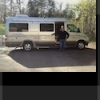Installing amateur radio in an RV
I’ve been an amateur (ham) radio operator for decades, My call is K8ZRH and there was a time when I was obsessed with the hobby, so caught up in making contacts with every state in the nation, every country in the world, that I stayed up all hours of the night tracking DX (distant) stations, Eventually, to keep peace in my marriage, I backed off and, for the past ten years or so, have been pretty much inactive.
Today, there’s an amateur radio transceiver installed in my RV. Not a CB radio, though that might also come in handy. You need to be licensed by the Federal Communications Commission to operate an amateur radio station. You can learn about that here. You do not need a license for a CB. Amateur radio is much more. Here’s how the American Radio Relay League describes it:
Anyway, my foray back into amateur radio came about after volunteering for the communications team that is part of my county’s Department of Homeland Security. My all electric, solar powered Roadtrek eTrek is a perfect vehicle to use in times of emergency and now, with the radio, I’m able to provide emergency communications with my own power supply when called up.
But I will also be able to have use of the radio as we travel the county.
The wife’s condition I had to agree to in installing the radio was that it had to be neat. 
No wires and ugly installation. No holes in anything. The photos show the results. I’m pretty happy. And it meet’s Jennifer’s approval.
The rig is a dual-bander (144/440MHz) Kenwood TM-V71A, I chose that rig because I generally like Kenwood two-way radios from my past experiences and this unit in particular has a detachable control head. I had to pick up an extension cable but I was able to locate the radio itself in an out of the way place hidden from view on a storage shelf above the driver’s seat. The control head, with the connecting cable hidden behind the trim, was Velcro-ed on a perfect spot just below and to the right of the steering wheel. I made no holes in the dash. The industrial strength Velcro I used can hold 10 pounds. I doubt the control head weighs more than 8 ounces. The radio itself is also Velcro-ed in place on the shelf so it doesn’t slide around.
The power connection is direct to one of the eTrek’s eight AGM batteries, accessed through an access panel located under-the-carpeting in the cab part of the van. The were were duct taped in place as they ran across the floor.
For an antenna I again had to choose neatness.
The non metal body of the Roadtrek makes getting a ground or using a traditional magnetic mount difficult.
So I selected the Larsen KG-2/70-CX-PL on glass antenna. Again, I snaked the antenna wire behind the trim to a place where it could reach the top right window on the second row passenger’s seat. The antenna, on a sticky pad, adheres to the outside of the glass while a coupler on the inside sticks to the glass exactly opposite for a very adequate inductive connection.
By the way, I’ve found that using a putty knife is a very simple way to gently pust wires and cable behing trim coverings. Use plastic ties under the dash to keep any wires from dangling down or showing themselves.
I get a solid SWR (hams will know what this means) of about 1.6 to 1.9 to one across most of the bands, more than acceptable. All of the local repeaters are full-quieting, meaning I’m receiving and transmitting well.
So there you go. I’m now K8ZRH mobile. My first add-on mod for my new eTrek.





0 Comments
Recommended Comments
There are no comments to display.
Please sign in to comment
You will be able to leave a comment after signing in
Sign In Now